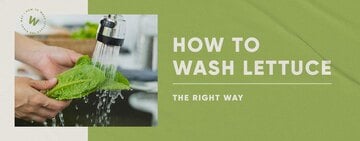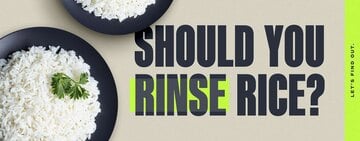You might be surprised to learn that mushrooms are naturally very clean. Cultivated mushrooms are grown in sterile compost that has been pasteurized to remove harmful bacteria. The specks of dirt that you see on store-bought mushrooms aren't harmful to consume, but they aren't very appetizing either. Unlike washing other types of produce, mushrooms do require some special handling. We’ll walk you through the best ways to clean mushrooms so they have the best texture and flavor in your dishes.
Shop MushroomsHow to Clean Mushrooms Before Cooking
Watch our video to learn how to wash mushrooms the right way.
Should You Wash Mushrooms?
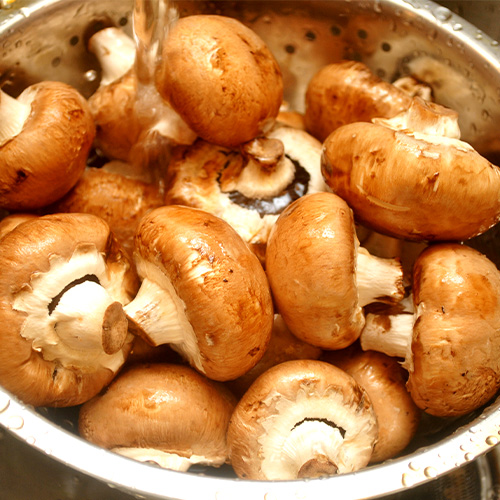
You can wash mushrooms with water, as long as you don't oversoak them. The mushroom dirt that you see clinging to your mushrooms is just small bits of peat compost. It won't make anyone sick, but this dirt can look unappealing and taste gritty. Washing or brushing off the dirt, especially if you are serving raw mushrooms in your salad bar, is a good practice. Mushrooms used for a plant-based dish will have the best meaty texture if you follow our cleaning tips.
Do You Need to Wash Wild Mushrooms?
Yes, you should wash wild mushrooms, especially morels, because they are likely harboring dirt, small twigs, and insects. If you are serving foraged mushrooms in your restaurant, you should check with your local jurisdiction to make sure you are abiding by food safety regulations. Some states require that wild mushrooms are approved by a mushroom expert before you serve them to guests. As a rule, you should never eat (or serve) any wild mushroom that you can't identify.
Note:
Never serve wild-foraged mushrooms raw. No matter how thoroughly you wash them, some varieties cannot be digested in their raw state. Cooking them thoroughly also ensures there is no risk of contamination by critters like slugs and snails.Mushroom Washing Tips
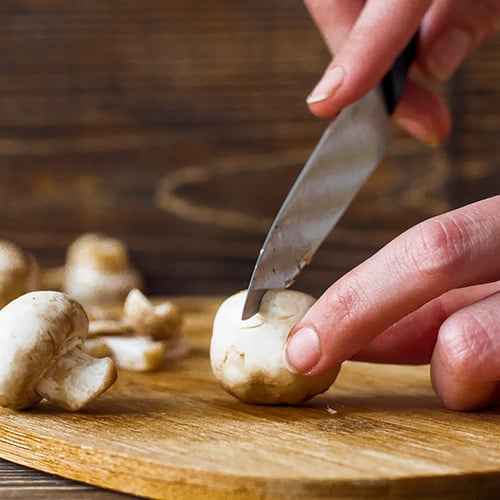
Mushrooms retain a lot of moisture. To achieve the right amount of browning and release a delicious umami flavor, the mushrooms must be as dry as possible before cooking. Some chefs refuse to wash their mushrooms because it makes it harder to reach the browning stage. Mushrooms that are too wet will remain soggy, and they won't have the same intense flavor. Follow our tips to avoid this pitfall:
- Don't Wash Ahead of Time - Wait to wash the mushrooms until you are ready to use them. If you wash them and place them in cold storage, they have a greater chance of becoming soggy.
- Don't Oversoak - Most mushrooms can't be soaked in water for a long period or they will become waterlogged.
- Dry the Mushrooms Completely - After washing, make sure to pat the mushrooms completely dry or use a salad spinner.
- Brush Them Instead - If you are working with delicate, expensive mushrooms, you may want to forego washing with water completely. Brushing the mushrooms clean takes longer, but you avoid the risk of waterlogging them.
How to Wash Mushrooms
Ready to start cleaning? We outline three popular methods for washing mushrooms below. If you are working with morel mushrooms or chanterelles, jump ahead for specific instructions. Portobellos, which have extra large caps, also require some extra steps.
1. Bowl Method
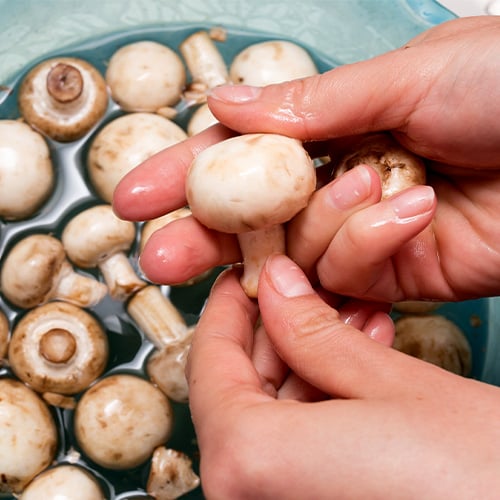
If you're working with foraged mushrooms or you just want to get them extra clean, it's best to give them a short soak. Follow these steps to wash your mushrooms with a bowl of water:
- Place mushrooms in bowl and cover with cool water.
- Swirl mushrooms with your fingers to loosen dirt and debris.
- Pour out water immediately.
- Place clean mushrooms on dry towel, making sure to spread them out in one layer.
- Gently pat with second towel until they are completely dry.
2. Rinse Method
If you're in a hurry, this is the quickest way to wash mushrooms. You'll need a colander and two drying towels.
- Place mushrooms in colander.
- Spray gentle stream of water over mushrooms.
- As you rinse, brush away dirt with your fingers.
- Place clean mushrooms on dry towel, making sure to spread them out in one layer.
- Gently pat them with a second towel until they are completely dry.
3. Brush Method
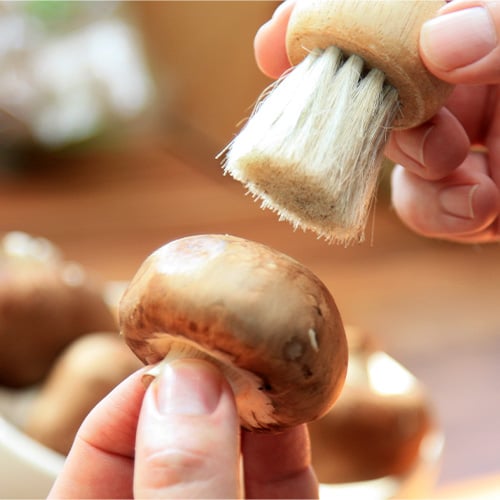
If you fall into the no-washing camp, you can clean many types of mushrooms with a little brushing. Use this method for store-bought mushrooms like white, button, and cremini. It also works for shitake, oyster, and enoki mushrooms. Grab a mushroom brush, pastry brush, or damp paper towel. Set up a bowl for the clean mushrooms to keep them separated. Work over a trash can or scrap bowl to collect the dirt as you clean.
- Pick up each mushroom and brush gently to remove any dirt.
- You might brush away some mushroom skin as you work, but this won't hurt the mushroom.
- Pay attention to area under cap and gills.
- Once every mushroom has been brushed, they are ready to be prepped.
How to Clean Morel Mushrooms
Morel mushrooms have a honeycomb-like texture which makes them trickier to clean. We recommend using a combination of brushing and washing to remove dirt from this wild mushroom.
- Brush outside of morels with mushroom brush or pastry brush.
- After brushing, cut morels in half lengthwise.
- Place morels in bowl of cool water and swirl to remove dirt.
- Pour out water immediately and lay out morels on towel to dry.
How to Clean Chanterelle Mushrooms
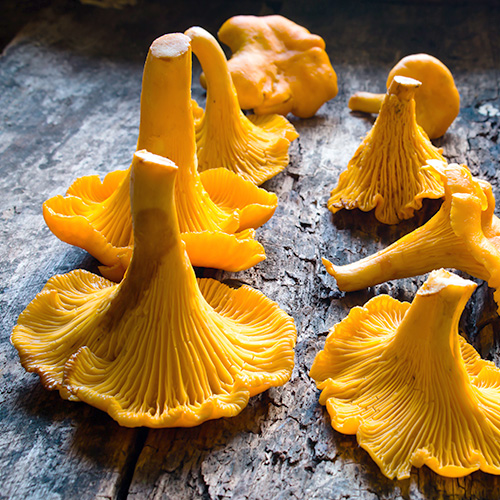
Chanterelles are a type of wild mushroom that can't be grown commercially. They can only be foraged, which is why you should give them extra care when you wash them. It's not uncommon for chanterelles to carry hitchhikers, especially in the summer. Use this method to wash your chanterelle mushrooms and remove any small insects.
- Add 1 tablespoon salt and 4 cups of water to large bowl.
- Place chanterelles in bowl and soak for 20 minutes.
- Carefully drain the water and repeat.
- Lay out chanterelles on a drying towel and pat dry.
How to Clean Portobello Mushrooms
Portobello mushrooms have a large cap, which makes a great plant-based meat substitute in sandwiches and entrees. Because the cap is so large, the underside is full of gills where dirt can hide. To clean your portobello caps the right way, follow these steps:
- First, remove mushroom stems by twisting them off (you can reserve these for making vegetable stock).
- Gently scrape away gills under the cap with spoon.
- Add mushroom caps to colander and rinse clean.
- Lay out portobello caps on towel and pat dry.
Mushrooms are a delicious and nutritious ingredient to add to your menu. If you've had trouble browning them in the past, you might be oversoaking these sponge-like morsels. The key to getting the best flavor when you cook with mushrooms is to keep them as dry as possible. Sometimes this requires just a simple brushing before cooking, but in the case of wild mushrooms, it's best to use some water to wash away any remnants of the forest where they grow.

